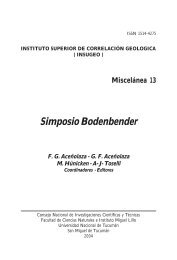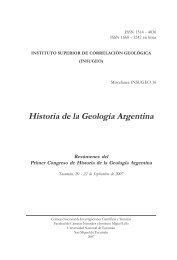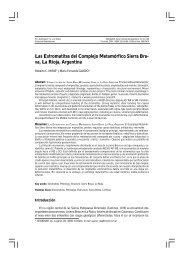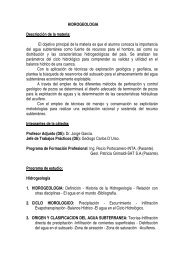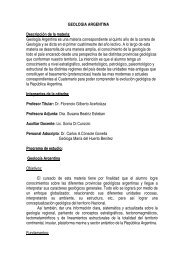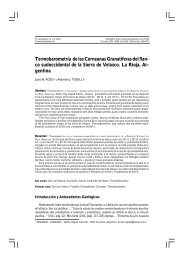Descargue esta publicació en formato pdf haciendo ... - INSUGEO
Descargue esta publicació en formato pdf haciendo ... - INSUGEO
Descargue esta publicació en formato pdf haciendo ... - INSUGEO
You also want an ePaper? Increase the reach of your titles
YUMPU automatically turns print PDFs into web optimized ePapers that Google loves.
R.R. LECH 13Stratigraphic distribution and geological age.- Although Orbiculoidea salt<strong>en</strong>sis Reed is m<strong>en</strong>tioned indiffer<strong>en</strong>t geological units of the Neopaleozoic of Arg<strong>en</strong>tina, this study confirms its pres<strong>en</strong>ce in theAgua del Jagüel, Ansilta and Santa El<strong>en</strong>a Formations. In addition to the fossil localities m<strong>en</strong>tionedin this work, O. salt<strong>en</strong>sis was described for the Esquina Gris Formation, Barreal (in Du Toit, 1927),and for the Quebrada Larga Formation, Punilla mountain (Antello, 1972), both formationsoutcropping in the province of San Juan, Arg<strong>en</strong>tina.The outcroppings of these formations are in the Precordillera of the provinces of San Juanand M<strong>en</strong>doza, Arg<strong>en</strong>tina. Also, the abundant fossiliferous record pres<strong>en</strong>t in these formations iswhat allows us to propose differ<strong>en</strong>t biozones, and more than one interpretation regarding thegeological ages attributed to them (see Azcuy et al. 2007; Césari et al. 2007; Gutiérrez 2006, 2008).In the Esquina Gris Formation, Orbiculoidea salt<strong>en</strong>sis is pres<strong>en</strong>t in the Biozone Balakhoniaperegrina – G<strong>en</strong>iculifera t<strong>en</strong>uiscostata, with an Upper Carboniferous age estimated by Taboada (1997).Instead, O. salt<strong>en</strong>sis is in the Quebrada Larga Formation with other marine invertebrates referringto the Biozone Tivertonia jachal<strong>en</strong>sis – Streptorhynchus inaequiornatus (Sabattini et al., 1991) with anestimated age late Late Carboniferous to early Early Permian (Archangelsky et al., 1996a).O. salt<strong>en</strong>sis is also pres<strong>en</strong>t in Agua del Jagüel Formation, in the fossiliferous zone N° 5, withHistosyrinx jaguel<strong>en</strong>sis (Lech), Costatumulus sp., Spiriferellina sp., Streptorhynchus inaequiornatus Leanza,and Crurithyris sp. This fossiliferous association is in the upper terms of the Agua del JagüelFormation, approximately 320 meters above the pillow lavas dated at 307.2 ± 5.2 million years,estimating its age in the late Late Carboniferous by Lech (2002).Koukharsky et al. (2005, 2009) confirmed this latest geological information provided by Lech(2002) and discovered new outcrops of volcanic rocks contemporaneous with the sedim<strong>en</strong>tationof the Agua del Jagüel Formation. Also, they analyzed the geochemical and isotopic data of thevolcanic rocks and suggested that were deposited in an <strong>en</strong>sialic retroarc marine basin during theUpper Carboniferous age.Instead, Taboada (2006) discarded the submarine magmatic ev<strong>en</strong>ts, also presupposes anunusual condition to the radiometric data pres<strong>en</strong>ted in Lech (2002) and based on the similaritybetwe<strong>en</strong> species in another region of Gondwana gives a younger age (Early Permian) to theBiozone Costatumulus amosi Taboada (1998) pres<strong>en</strong>t in Agua del Jagüel Formation. This youngerage assigned to this formation is based on comparison with the marine invertebrates described forthe Permian of Australia, where there are not geological records to the "Late P<strong>en</strong>nsylvaniano" (cfr.Azcuy et al., 2007).One of the brachiopod associated to the Biozone Costatumulus amosi in the Agua del JagüelFormation is Coolkilella keideli Taboada (1998), with a Lower Permian age for comparison withsimilar species from the Permian of Australia (Taboada, 1998).Also, it may be pres<strong>en</strong>t in the fossiliferous Zone 2 (= Cancrinella? sp. in Lech et al., 1998) tothe Ciénaga Larga del Tontal Formation (Banchig et al., 1998; Barredo and Ottone, 2003), TontalMountain, San Juan. The estimated age of this formation is late Early Carboniferous to late LateCarboniferous, based both in the marine invertebrate fossils associations (Banchig et al., 1998;Lech and Milana, 2006), as in the palinological association sub-biozone A of the BiozoneRaistrickia d<strong>en</strong>sa - Convolutispora muriornata as reported by Barredo and Ottone (2003), of the earlyLate Carboniferous age (Césari and Gutierrez, 2000).Lech and Raverta (2005) suggested that the association of brachiopod fossils in the Agua delJagüel Formation are a mixture of species of the biozones of Tivertonia jachal<strong>en</strong>sis - Streptorhynchusinaequiornatus and Costatumulus amosi. Instead, Taboada (2006) considered that there isbiocronological contiguity betwe<strong>en</strong> the biozones by the occurr<strong>en</strong>ce of taxa in common. It is alsopossible that the mixture of these biozones is due both to the biostratigraphic contiguity, as wellas by <strong>en</strong>vironm<strong>en</strong>tal factors as suggested by Cisterna et al. (2006).Other brachiopod associated to the Biozone of Costatumulus amosi also pres<strong>en</strong>t at the Aguadel Jagüel Formation, is Tivertonia leanzai Taboada (2006). This species is similar to T. jachal<strong>en</strong>sis(Leanza) but both are attributed differ<strong>en</strong>t geologic ages. Tivertonia jachal<strong>en</strong>sis with Streptorhynchusinaequiornatus Leanza are indicative of the Biozone T. jachal<strong>en</strong>sis – S. inaequiornatus (Sabattini et al.1991), which restrained the pres<strong>en</strong>ce of both species in this biozone by Archangelsky et al. (1996a,


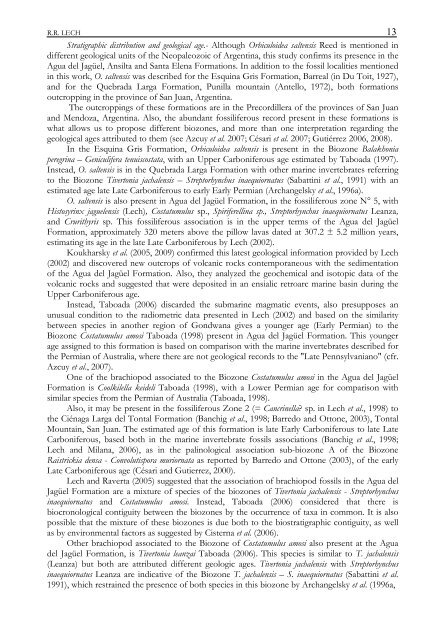
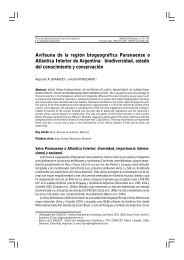

![Descargar El Libro Completo [5.631 Kb] - INSUGEO](https://img.yumpu.com/40710231/1/177x260/descargar-el-libro-completo-5631-kb-insugeo.jpg?quality=85)

